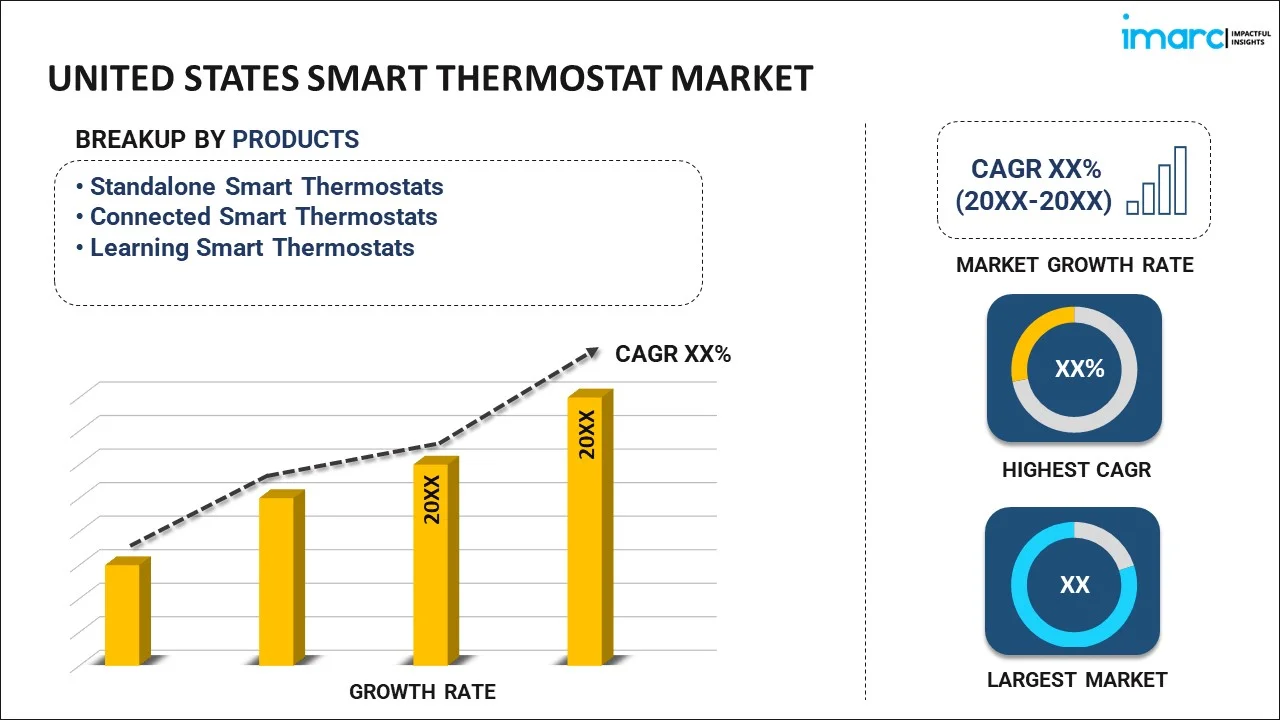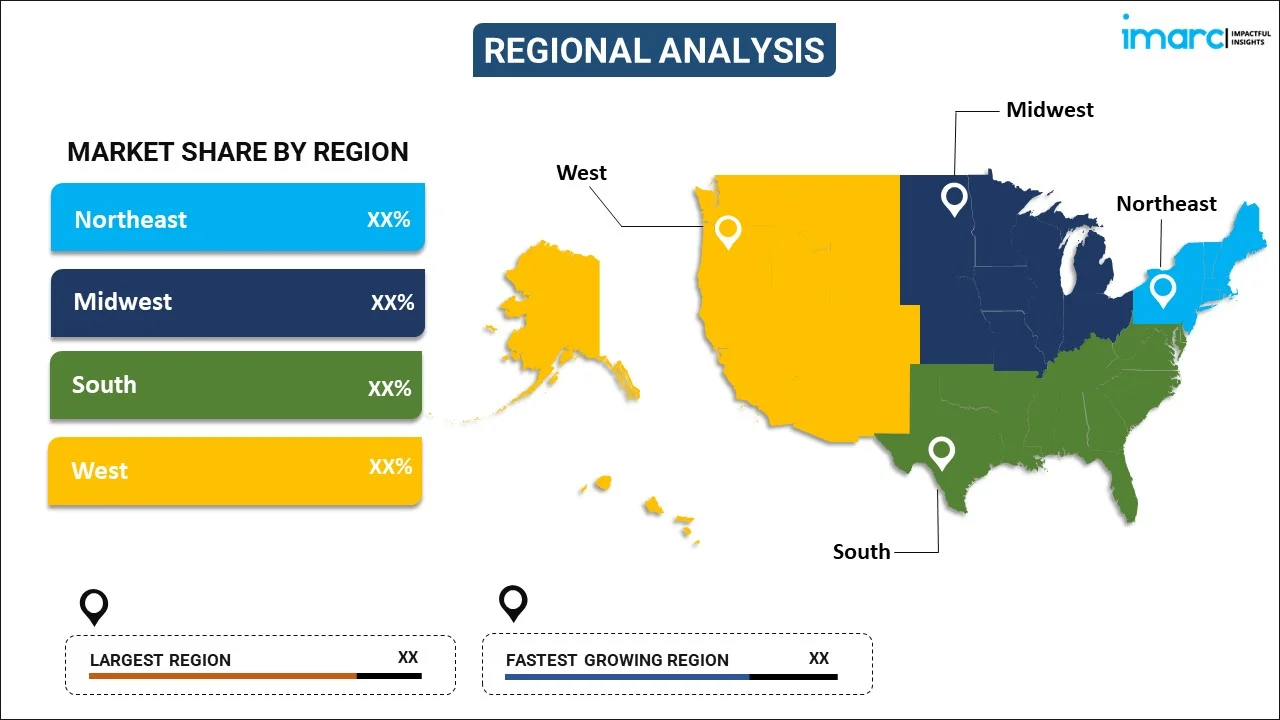
United States Smart Thermostat Market Report by Product (Standalone Smart Thermostats, Connected Smart Thermostats, Learning Smart Thermostats), Component (Display, Temperature Sensors, Humidity Sensors, Motion Sensors, and Others), Technology (Wired, Wireless), Application (Residential, Commercial, Industrial), and Region 2025-2033
Market Overview:
United States smart thermostat market size reached USD 1,036.6 Million in 2024. Looking forward, IMARC Group expects the market to reach USD 4,132.1 Million by 2033, exhibiting a growth rate (CAGR) of 16.6% during 2025-2033. The increasing awareness of energy efficiency, growing popularity of smart homes, recent advancements in machine learning (ML) and artificial intelligence (AI), and the introduction of favorable government incentives and rebates represent some of the key factors driving the United States smart thermostat market share.
|
Report Attribute
|
Key Statistics
|
|---|---|
|
Base Year
|
2024 |
|
Forecast Years
|
2025-2033
|
|
Historical Years
|
2019-2024
|
| Market Size in 2024 | USD 1,036.6 Million |
| Market Forecast in 2033 | USD 4,132.1 Million |
| Market Growth Rate (2025-2033) | 16.6% |
United States Smart Thermostat Market Analysis:
- Growth Drivers: Growing energy‑efficiency awareness, supportive government initiatives, increased smart‑home adoption, utility incentives, and integration of Internet of Things (IoT) with HVAC systems are major factors driving smart thermostat adoption across residential and commercial segments in the U.S.
- Key Market Trends: AI‑enabled learning thermostats, voice‑assistant integration, enhanced user interfaces, growing interoperability standards, and adoption of energy‑saving automation features are key trends shaping the evolution of the United States smart thermostat market analysis.
- Market Opportunities: Significant market prospects are presented by factors such as increased demand for multi-unit housing, integration with renewable energy systems, development into commercial areas, partnerships with utilities for energy programs, and customer preference for connected products.
- Market Challenges: High upfront costs, HVAC system compatibility issues, limited technical knowledge among users, data privacy concerns, and inconsistent state‑level regulations remain major challenges for widespread smart thermostat adoption in the U.S.
A smart thermostat refers to an advanced technology designed to regulate temperature within a living space or office environment. They are categorized into Wi-Fi, Zigbee, Z-Wave, and others, each offering unique connectivity features. Smart thermostats comprise several components, such as temperature sensors, motion sensors, humidity sensors, and processors. They are constructed using robust materials like plastics, metals, and advanced composites. The manufacturing process of smart thermostats involves sophisticated assembly lines with precision engineering to ensure reliability and efficiency. They find applications in diverse areas, including residential homes, commercial buildings, educational institutions, healthcare facilities, retail spaces, industrial units, hospitality venues, government buildings, transportation systems, and smart city projects. Smart thermostats are known for their energy savings, cost-effectiveness, convenience, remote accessibility, enhanced comfort, user-friendly interfaces, compatibility with smart home systems, real-time data analysis, and environmental sustainability. In addition, they provide several advantages, such as reduced carbon footprint, adaptability to changing weather conditions, learning capabilities, integration with other smart devices, customizable settings, occupancy detection, voice control compatibility, programmable features, and usage tracking for better energy management.
United States Smart Thermostat Market Trends:
Rising Energy-Efficiency Awareness and Cost Savings
Energy efficiency and cost reduction remain key forces driving United States smart thermostat market growth in the U.S. Heating and cooling are among the largest contributors to household energy use, making them ideal areas for optimization. Smart thermostats automatically learn user habits, adjust temperatures based on occupancy, and respond to environmental changes to minimize unnecessary energy consumption. This combination of automation and intelligent control enables households and businesses to maintain comfort while reducing energy waste. As utility costs fluctuate, many consumers see these devices as an effective way to manage expenses while also supporting broader sustainability goals. Growing awareness of environmental responsibility and the long-term benefits of energy-efficient technology makes smart thermostats a compelling upgrade. They offer an attractive balance of comfort, cost management, and eco-friendly operation, appealing to both individual homeowners and commercial property managers.
IoT & Smart-Home Ecosystem Integration
Smart thermostats are no longer single devices being central players in expanding smart-home systems. Customers now demand seamless interoperability with voice assistants such as Amazon Alexa, Google Home, and Apple HomeKit to unlock voice control, remote control, and multi-device automation. They communicate over Wi-Fi, Zigbee, or Z-Wave and typically feature geofencing, energy usage monitoring, and adaptive scheduling, adding convenience and control. Since more than 80% of new houses in the U.S. have smart-ready infrastructure, connected thermostats are becoming the norm. Having the capability to integrate heating and cooling with lighting, security, and appliance control further enhances their attractiveness. This integration provides a very customizable environment to optimize comfort while conserving energy. As usage of IoT increases, thermostats that are marketed as being part of a smart ecosystem will continue to experience high market penetration.
Government Incentives, Energy Regulations & Utility Programs
Government programs, state policies, and utility schemes is a key United States smart thermostat market trends boosting penetration throughout the U.S. Federal and state governments offer incentives, tax credits, and rebates on the installation of ENERGY STAR-certified thermostats, essentially reducing initial costs. Utilities also provide demand-response programs—such as Nest's "Rush Hour Rewards"—that pay users for adapting energy use during peak times, lowering grid strain. Such programs offer tangible financial incentives while promoting sustainable energy habits. In addition, Department of Energy and Environmental Protection Agency regulations favor the extensive adoption of networked HVAC systems to satisfy energy efficiency and greenhouse gas emissions reduction goals. Combined, these efforts provide a positive policy climate, which urges homeowners and businesses to shift to intelligent thermostats. As decarbonization and grid efficiency concerns become increasingly important, these kinds of incentives are likely to be a good market driver in the future years as well.
United States Smart Thermostat Market Segmentation:
IMARC Group provides an analysis of the key trends in each segment of the market, along with forecasts at the country level for 2025-2033. Our report has categorized the market based on product, component, technology, and application.
Product Insights:

To get more information on this market, Request Sample
- Standalone Smart Thermostats
- Connected Smart Thermostats
- Learning Smart Thermostats
The report has provided a detailed breakup and analysis of the market based on the product. This includes standalone smart thermostats, connected smart thermostats, and learning smart thermostats.
Component Insights:
- Display
- Temperature Sensors
- Humidity Sensors
- Motion Sensors
- Others
A detailed breakup and analysis of the market based on component have also been provided in the report. This includes display, temperature sensors, humidity sensors, motion sensors, and others.
Technology Insights:
- Wired
- Wireless
- WiFi
- Zig Bee
- Others
The report has provided a detailed breakup and analysis of the market based on the technology. This includes wired and wireless (wifi, zig bee, and others).
Application Insights:
- Residential
- Commercial
- Industrial
A detailed breakup and analysis of the market based on application have also been provided in the report. This includes residential, commercial, and industrial.
Regional Insights:

- Northeast
- Midwest
- South
- West
The report has also provided a comprehensive analysis of all the major regional markets, which include the Northeast, Midwest, South, and West.
Competitive Landscape:
The market research report has also provided a comprehensive analysis of the competitive landscape in the market. Competitive analysis such as market structure, key player positioning, top winning strategies, competitive dashboard, and company evaluation quadrant has been covered in the report. Also, detailed profiles of all major companies have been provided.
Latest News and Developments:
- In July 2025, Alarm.com launched the ADC‑T25 Smart Thermostat, designed by Building36 for easy installation and affordability. Compatible with most HVAC systems, it features flexible wiring, battery operation without a C‑wire, and auto‑configuration. Integrated with the Alarm.com platform, it offers remote control, customizable automations, and monthly efficiency reports with system insights—bringing advanced smart climate control to a wider customer base at an accessible price.
- In December 2024, Building36, an Alarm.com company, launched the Smart Thermostat HQ, featuring built‑in cellular connectivity and a smart home hub. Designed for contractors, it simplifies installation and ensures reliable homeowner connectivity. The device offers effortless setup, enhanced integration with smart home systems, and continuous remote access for improved comfort and efficiency. This next‑generation thermostat underscores Building36’s focus on making smart climate control more accessible and dependable for homeowners and professionals.
- In February 2024, Carrier introduced the Carrier Smart Thermostat, debuting at the International Builders’ Show in Las Vegas. Designed for affordability and easy installation, it features tool‑free wiring, a C‑wire adaptor, smart home integration, and an optional 5‑year warranty when connected. Supporting accessories and offering full control via the Carrier Home App, this thermostat aims to meet builder and homeowner needs.
United States Smart Thermostat Market Report Coverage:
| Report Features | Details |
|---|---|
| Base Year of the Analysis | 2024 |
| Historical Period | 2019-2024 |
| Forecast Period | 2025-2033 |
| Units | Million USD |
| Scope of the Report | Exploration of Historical Trends and Market Outlook, Industry Catalysts and Challenges, Segment-Wise Historical and Future Market Assessment:
|
| Products Covered | Standalone Smart Thermostats, Connected Smart Thermostats, Learning Smart Thermostats |
| Components Covered | Display, Temperature Sensors, Humidity Sensors, Motion Sensors, Others |
| Technologies Covered |
|
| Applications Covered | Residential, Commercial, Industrial |
| Regions Covered | Northeast, Midwest, South, West |
| Customization Scope | 10% Free Customization |
| Post-Sale Analyst Support | 10-12 Weeks |
| Delivery Format | PDF and Excel through Email (We can also provide the editable version of the report in PPT/Word format on special request) |
Key Benefits for Stakeholders:
- IMARC’s industry report offers a comprehensive quantitative analysis of various market segments, historical and current market trends, market forecasts, and dynamics of the United States smart thermostat market from 2019-2033.
- The research report provides the latest information on the market drivers, challenges, and opportunities in the United States smart thermostat market.
- Porter's five forces analysis assist stakeholders in assessing the impact of new entrants, competitive rivalry, supplier power, buyer power, and the threat of substitution. It helps stakeholders to analyze the level of competition within the United States smart thermostat industry and its attractiveness.
- A competitive landscape allows stakeholders to understand their competitive environment and provides an insight into the current positions of key players in the market.
Key Questions Answered in This Report
The smart thermostat market in the United States was valued at USD 1,036.6 Million in 2024.
The United States smart thermostat market is projected to exhibit a CAGR of 16.6% during 2025-2033, reaching a value of USD 4,132.1 Million by 2033.
The U.S. smart thermostat market is driven by increasing demand for energy-efficient home solutions, growing awareness of sustainable living, and wider adoption of smart-home technologies. Advancements in AI and IoT are making these devices more intuitive and integrated, while builders and homeowners seek enhanced comfort and control. Supportive government initiatives, easy installation options, and expanding compatibility with modern HVAC systems further accelerate adoption across residential and commercial spaces, strengthening the market’s growth trajectory.
Need more help?
- Speak to our experienced analysts for insights on the current market scenarios.
- Include additional segments and countries to customize the report as per your requirement.
- Gain an unparalleled competitive advantage in your domain by understanding how to utilize the report and positively impacting your operations and revenue.
- For further assistance, please connect with our analysts.
 Request Customization
Request Customization
 Speak to an Analyst
Speak to an Analyst
 Request Brochure
Request Brochure
 Inquire Before Buying
Inquire Before Buying




.webp)




.webp)












